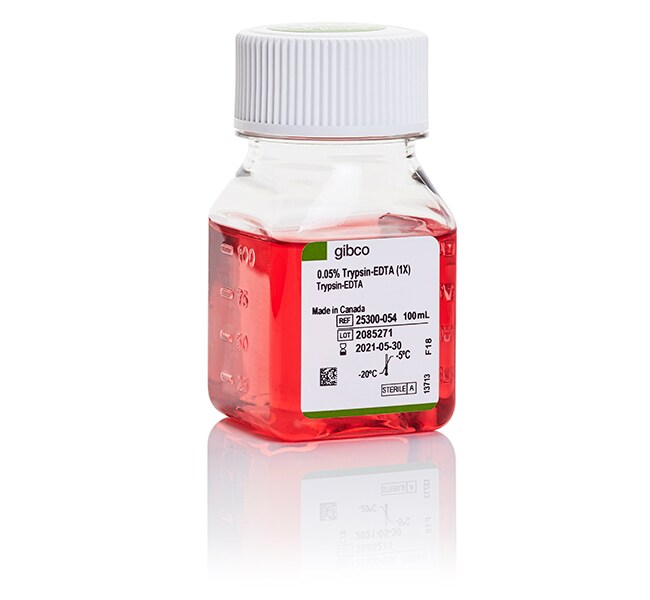Search Thermo Fisher Scientific

Trypsin-EDTA (0.05%), phenol red
| 製品番号(カタログ番号) | 数量 |
|---|---|
| 25300054 | 100 mL |
| 25300062 | 500 mL |
| 25300120 | 20 x 100 mL |
We offer a variety of trypsin formulations and animal origin-free TrypLE reagent that feature:
• Quality Testing
• Documented Traceability
• Dual-site cGMP Manufacturing
This trypsin solution is modified as follows:
With
• EDTA
• Phenol Red
The complete formulation is available.
Quality Testing
Gibco Trypsin solutions are tested for pH, osmolality, sterility, and performance. In addition, the raw materials are verified for e-beam irradiation and precursor lots are tested for endotoxin, PPV, PCV 1/2, mycoplasma, bacterial, fungal, and viral contamination, as well as multiple activity assays, ash analysis, and moisture analysis.
Documented Traceability
We can provide detailed documentation to meet your regulatory needs. Gibco Trypsin information available includes lot traceability, animal origin certificates, lot analyses, irradiation certificates, a viral inactivation summary, and supply chain transparency.
cGMP Manufacturing and Quality System
For supply chain continuity, we manufacture Gibco Trypsin-EDTA (0.05%), phenol red at two separate facilities located in Grand Island, NY and Scotland, UK. Both sites are compliant with cGMP manufacturing requirements and are certified to the ISO 13485 standard.
Shelf life: 24 months from date of manufacture

Follow the 5 steps to publication-quality fixed-cell imaging.
Download your free 5-step guide today ›
Customers who viewed this item also viewed
ドキュメントおよびダウンロード
証明書
Safety Data Sheets
Scientific Resources
よくあるご質問(FAQ)
Dissociation of cells from Primary Tissue TRYPSIN COLLAGENASE DISPASE REFERENCE:
1. After dissecting off unusable tissue, mince the remaining tissue into 3 to 4 mm pieces with a sterile scalpel or scissors. Wash the tissue pieces by resuspending in a balanced salt solution without calcium and magnesium. Allow the tissue pieces to settle, and remove the supernatant. Repeat the wash 2 or 3 times.
2. Place the container with the tissue pieces on ice, and remove any remaining supernatant. Add 0.25% trypsin in a balanced salt solution without calcium or magnesium (1 ml of trypsin for every 100 mg of tissue).
3. Incubate at 4°C for 6 to 18 h to maximize penetration of the enzyme with little trypsin activity.
4. Decant and discard the trypsin from the tissue pieces. Incubate the tissue pieces with residual trypsin at 37°C for 20 to 30 min.
5. Add warm, complete media to the tissue pieces and gently disperse the tissue by pipetting. If using a serum-free medium, also add soybean trypsin inhibitor.
6. Filter the cell suspension through sterile, stainless steel mesh (100 to 200 µm) to completely disperse any remaining tissue. Count and seed the cells for culture.
1. Mince tissue into 3 to 4 mm pieces with a sterile scalpel or scissors. Wash the tissue pieces several times with Hanks' Balanced Salt Solution (HBSS).
2. Add collagenase (50 to 200 U/ml in HBSS).
3. Incubate at 37°C for 4 to 18 h. Addition of 3 mM CaCl2 increases the efficiency of dissociation.
4. Filter the cell suspension through a sterile stainless steel or nylon mesh to separate the dispersed cells and tissue fragments from the larger pieces. Fresh collagenase can be added to the fragments if further disaggregation is required.
5. Wash suspension several times by centrifugation in HBSS.
6. Resuspend the pellet in culture medium. Count and seed the cells for culture.
1. Mince tissue into 3 to 4 mm pieces with a sterile scalpel or scissors. Wash the tissue pieces several times in a calcium and magnesium-free balanced salt solution.
2. Add dispase (0.6 to 2.4 U/ml in calcium and magnesium-free balanced salt solution).
3. Incubate at 37°C for 20 min to several hours.
4. Filter the cell suspension through a sterile, stainless steel or nylon mesh to separate the dispersed cells and tissue fragments from the larger pieces. Fresh dispase can be added to the fragments if further disaggregation is required.
5. Wash suspension several times by centrifugation in the balanced salt solution.
6. Resuspend the pellet in culture medium. Count and seed the cells for culture.
Freshney, R. (1987) Culture of Animal Cells: A Manual of Basic Technique, p. 117, Alan R. Liss, Inc., New York.
The basal Diploid Growth Serum-Reduced Medium already contains 6 mM L-glutamine.
Find additional tips, troubleshooting help, and resources within our Cell Culture Support Center.
We recommend evaluating performance with Diploid Production Serum-Free Medium using current conditions, however, multiplicity of infection, time of infection, and time of harvest may be different than with conventional media. Closely monitor cells for cytopathic effect and evaluate viral titers at multiple time points.
Find additional tips, troubleshooting help, and resources within our Cell Culture Support Center.
Diploid Growth Serum-Reduced Medium can be supplemented with Fetal Bovine Serum, Newborn Calf Serum, Donor Bovine Serum with Iron, or Bovine Serum.
Find additional tips, troubleshooting help, and resources within our Cell Culture Support Center.
Diploid Growth Serum-Reduced Medium has been evaluated with fibroblast cell lines, including MRC-5, WI-38, IMR-90, BS-2, and CEF cells.
Find additional tips, troubleshooting help, and resources within our Cell Culture Support Center.
